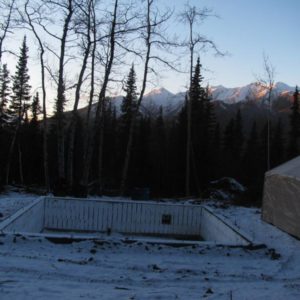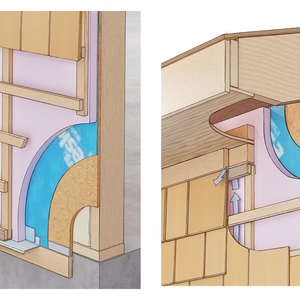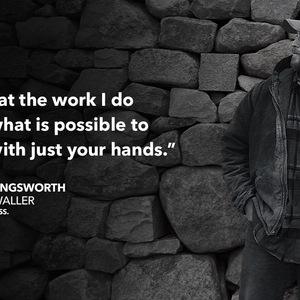Alaska… Radiant floor. Also, any benift to thermal mass w/o radiant heat?

I am building in interior Alaska where -20 is not unusual and -40 possible during a cold snap. It’s been sub -40 the last few days. So it’s a cold climate
I have a footing in the ground with a 4 ft. ICF perimiter wall (8″ concrete w. 2″ foam inside and outside) that extends about 8″ above grade. Am planning to add a short stem wal so I don’t have to crawl in the crawlspace.
Mostly I will heat the place with wood.
It will be 2 story at 25×25′. 2×6 walls with additional 4″ foam insulation on exterior of sheathing.
I had considered putting a thermal mass floor above the crawlspace with PEX radiant heat as auxilary heat and also to be there when I get older and tired of hauling firewood around.
But after looking at fuel consumption rates for oil fired water heaters (half a gallon an hour… really?) I am re-considering.
So a couple of questions.
What’s the best I can do in terms of fuel consumption for an oil water heater? Oil is expensive out here and wood is cheap so this may not make sense for me.
One issue with a lot of homes in this climate is heat stratification. A big cause is cold floors. Lots of folks are building on blocks or sonotubes and often don’t even skirt.
So my foundation and plans for a really tight seal all around should help with air infiltration and a warmer floor.
This is a big reason i was thinking radiant floor. But I was wondering if there is any benefit to having thermal mass in the floor even without a radiant heat system. My thinking is that it might also help to even out the fluctuations you normally get with wood heating.
I plan to have a ceiling fan and a few other methods of circulating air but not full blown duct system.
So would there be any benefit to the mass in-floor without radiant heat?
Thanks
Greg




















Replies
Have you taken a look at any ideas the finn's have?
Their masonry heaters are killer and their weather might not be too darn far off yours. They might have some coupled systems that evolves off their masonry heat.
And if nothing else, I'll give you a thumbs up on that form of heat for the mass, heat retention and volume of fuel used.
If you heat continuously, there's no harm in thermal mass but no real benefit either, no matter how you heat. And if you heat intermittently (with fuel you pay for) then the thermal mass needs to be warmed up and it takes longer (and more $$$) to heat. I don't see how thermal mass can help you much if you don't have reasonably "free" intermittent heat (eg, solar, or maybe wood).
What you may want to consider is some sort of air movement system -- something that will gather warm air near the ceiling and recirculate it near the floor, especially around the perimenter of the building. This will cost something to operate and a little more in terms of additional heat loss, but the increase in comfort will likely offset that. (And there might be some way to tie this in with a heat exchanger on the stove.)
And of course, seal and insulate the hell out of the thing.
I guess my idea was that the mass coud release heat during the night when the wood stove tends to burn down. But as you say, next morning you need to heat it back up again. Hmmm.
Definitley plan to super-insulate and especialy focus on vapor sealing: sheathing to overlap all framing joints and sill plates, taping OSB sheathing, overlapping and seam taped exterior foamboard, etc.
I have been thinking about the circulation issue. Definitly need to do that but keep power consumption down. Like I said, don't want to get into a lot of duct work.
How about a wood fired boiler with water storage and a ciurculation system to heat the floor?
with the right water heater
I can circulate a system of this size with no more than 10 watts of power AC.
also the half a gallon an hour of oil for the water heater is if it ran for a full hour... maximum capacity. it would only do that if your heat load were in the 60,000 BTUs/hr range. if you do your due dilligence on this envelope, you should be able to ensure that your max load is somewhere closer to 10,000 BTUs/hr per floor (ballpark guess).
Thermal mas in and of itself doesn't improve energy. But as Dan hinted ... the mass may help w/ a wood stove. Often wood stoves tend to overheat spaces and then as you said, at night it dies down. The mass would aid this by providing a bit of a flywheel.
But to go out of your way to put mass in may not be a good thing (i.e. economical). You're doing a crawlspace, so you're talking about a suspended slab. I think I would tend to leave the wood floor and then put in a system to distribute the wood heat throughout the house better than natural circulation (e.g. ducts and fan to redistribute that excess heat to other areas).
You know, they do make wood and pellet fired boilers.
If ou have a two story home, you have to figure out how to keep that light weight hot ait downstairs where you need it, and sometimes the cold air upstairs too. Ceiling fans don't cut it, unless you live in a 2 story tent.
It doesn't have to complex, but you will need to pull the hot air from upstairs back down again somehow. Even a bathfan in a hallway on a timer ducted downstairs will do the trick.
One of the best things about in-floor radiant heat is that the thermal layering is eliminated. No need for ceiling fans as a wood stove would demand. If I were you, I'd try to figure out a way to combine wood burning and radiant. It will probably demand a lot of attention, but wood heat always does.
You are absolutely right
One of the best things about in-floor radiant heat is that the thermal layering is eliminated.
I'd like to add this. A partial open floor plan down, fully radiant in the slab, with a great room opening in one corner (whole room) that goes up to the second floor. Balcony overlooks, with 3 Bedrooms - one open to the great room with a large opening, the other two in the rear corner of the house. In these two rooms we have a 4- HW baseboard, but included an open vent down to the rear corner laundry mudroom area . The warm air circulates via natural convection, up from the great room, through the MBR or down the hall and back down those vents to the laundry. I'm going to guess the lack of a fire stop between the floor vents is not the best of an idea and perhaps not to existing codes.
Whether heating with the masonry heater or the floor heat below-it is not HOT up and COOL down. Quite the opposite. We included the basebds in the two remote BR's more for individual comfort. With the doors open or perhaps with a transom open, perfectly comfortable in low 60's in winter.
Surprised also that one window air cond. could cool the entire house (ac placed in upper window of great room) in the summer. Sure, cooler down than up, but nothing like the drastic changes in many a forced air house w/o even the open areas. Shaded by trees and 2' overhangs certainly add to the natural cooling of the upper floor.
HRV system to solve stratification as well as ventilation?
Lots of good input here and I appreciate all the help.
Even though I do think that a thermal mass sans radiant would help to even out temp fluxes, I am leaning towards the idea that it would not be worth the extra expense and labor.
As I mentioned and some here have addressed, stratification is a major issue with wood heat. Ceiling fans, as pointed out, just don't do the trick.
I only just found out about HRV systems recently. Obviously this is an owner/builder operation :-)
But I'm wondering.. would a small HRV system solve both the ventilation issue as well as circulating air and fixing the stratification problem? This house will be super insulated and as tight as possible so HRV seems like not a bad idea.
The footprint is 25x25. The first floor will be totally open with no interior partition walls to maximize radiant heat distribution from the wood stove. Also I just like a wide open layout, especialy sinse it's not huge. Well actually this is fairly big by McCarthy standards.
The second floor will be a bit less open with a bathroom and bedroom but still no load bearing walls.
I'm wondering with such an open design could I get away with a fairly simple system of just one or two ducting columns.
Oh, the floor will be 4x8 beams hung off a glulam beam down the middle. 2x6 T&G flooring above will form the floor/ceiling. So I can't be running any ducting or anything else, under the 2nd floor deck.
Given the open layout, what would be the simplest design for an HRV system?
Where should I place the air intakes and outputs? Any good site for DIY builders to get HRV design ideas?
This is only about 1300 SF so can anyone recommend a small and efficient HRV? This house will be off-grid so power usage is always a concern.
Oh, does the HRV unit need to be in a heated space or can that go in the insulated crawlspace?
Thanks.
Well, an HRV doesn't go very far to solve your recirculation problem since you want the HRV to be drawing air from the coldest part of the structure (to have the least heat loss).
I disagree with danH
First, if you are superinsulated you NEED an HRV/ERV. We like ERVs to prevent overdrying but in your climate that means a preheater in very cold weather. not much energy, but if you're off the grid, every watt adds up.
a good HRV like a Venmar EKO can use as little as 40 watts on low speed.
it would indeed help with your recirc issues as long as you are supplying to major rooms (beds, etc) and pulling from baths and the high point (presuming stratification)
I didn't disagree that some sort of HRV/ERV system is needed. I just said it's not the solution to the stratification problem.
yep
and I disagreed with that assessment. good HRV/ERV design can even out temperature variations pretty significantly.
Wood stove with water coils
There are a couple of older woodstoves, that I take care of that have water jackets in them to heat water, and are connected to radiators in other rooms. There aren't any pumps, they just thermal siphon.
Not sure they are still available.
Thermal mass with wood is a good idea, but like somone else said, you should look at the soap stone stoves the Finns are still using. The mass is mostly in the stove, and it will radiate heat for hours longer than any other wood fired heating device.
I agree with Jigs and others
on putting the mass on the stove if you're using the stove mostly.
if you added radiant, adding it low mass would be the best match with an intermittant heat source like a wood stove. then the radiant can drop out quickly as the wood sources comes up to speed, and take over again easily when the wood stove slows its output down.
One solution and information source
I built a super-insulated house when I lived in Fairbanks in the late 70's and to prevent cold floors I installed 2x sleepers inside the vapor barrier and then built the finished floor above. The space created was used as a return air duct for forced air heat. It would be straight forward to set up a duct system to pull air from near the ceiling through the floor.
When I was living in the Interior, UAF had some great reference material. I still have my copy of Axel Carlson's booklet on super-insulation. You may want to check with the Extension Service at UAF. Enjoy the lights.